

Professor John Craig Venter
King Faisal Prize in Science 2000 Laureate
Topic: "Biology "
I majored in science to find understanding and perhaps change the world in some small way

John Venter began his formal education at a community college in California, where he proceeded to obtain a B.A. in Biochemistry and a Ph.D. in Physiology and Pharmacology from the University of California, San Diego. In 1976, he started teaching at the Colleges of Medicine and Dentistry at the State University of New York (SUNY), where he rose to the rank of research professor in 1984. Between 1984-1992, he joined the National Institutes of Health (NIH), in Bethesda, Maryland, where he directed the Receptor Biochemistry and Molecular Biology laboratories. In 1992, he founded the Institute for Genomic Research (TIGR), a non-profit research institute.
Professor Venter is a world authority on genomic sequencing. He was the first to put high throughput automated DNA sequencing into practice, and the first to develop the highly efficient expressed sequence tags (EST) method for developing whole genome random sequencing strategy for rapidly decoding entire organismal genomes. The EST has fundamentally altered the process of gene discovery worldwide and greatly accelerated the discovery of human genes. Using the whole genome shotgun, Venter sequenced the first genome of a free-living organism, the bacterium Haemophilus influenzae. This landmark achievement was soon followed by the sequencing of entire genomes of other organisms, and was key to the subsequent success in sequencing the human genome. Using DNA from 5 human volunteers, including himself, Venter generated the human genome sequence. In 2000, he and rival scientist Francis Collins of the NIH, along with the U.S. President Bill Clinton made the stunning announcement of the mapping of the human genome; Venter and Collins then shared the Biography of the Year award.
Professor Venter published hundreds of scientific papers in prestigious journals. He also received several awards and honors from academic, industrial, and biotechnology groups, as well honorary doctorate degrees and invited lectureships. He was also the subject of articles in several magazines as well as documentary television series.
This biography was written in the year the prize was awarded.
- He was appointed the President of the John Craig Venter Institute, which carries out research in synthetic biology.
- He co-founded Synthetic Genomics in 2005.
- In 2007 and 2008, Time magazine listed him among the 100 most influential people in the world.
- He received the American Medal for Science in 2008.
- The New Statesman ranked 14th in its list of “The World’s 50 Most Influential Figures of the Year” in 2010.



